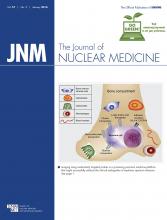Abstract
With the increasing availability of integrated PET/MR scanners, the utility and need for MR contrast agents for combined scans is questioned. The purpose of our study was to evaluate whether administration of gadolinium chelates is necessary for evaluation of pediatric tumors on 18F-FDG PET/MR images. Methods: First, in 119 pediatric patients with primary and secondary tumors, we used 14 diagnostic criteria to compare the accuracy of several MR sequences: unenhanced T2-weighted fast spin-echo imaging; unenhanced diffusion-weighted imaging; and—before and after gadolinium chelate contrast enhancement—T1-weighted 3-dimensional spoiled gradient echo LAVA (liver acquisition with volume acquisition) imaging. Next, in a subset of 36 patients who had undergone 18F-FDG PET within 3 wk of MRI, we fused the PET images with the unenhanced T2-weighted MR images (unenhanced 18F-FDG PET/MRI) and the enhanced T1-weighted MR images (enhanced 18F-FDG PET/MRI). Using the McNemar test, we compared the accuracy of the two types of fused images using the 14 diagnostic criteria. We also evaluated the concordance between 18F-FDG avidity and gadolinium chelate enhancement. The standard of reference was histopathologic results, surgical notes, and follow-up imaging. Results: There was no significant difference in diagnostic accuracy between the unenhanced and enhanced MR images. Accordingly, there was no significant difference in diagnostic accuracy between the unenhanced and enhanced 18F-FDG PET/MR images. 18F-FDG avidity and gadolinium chelate enhancement were concordant in 30 of the 36 patients and 106 of their 123 tumors. Conclusion: Gadolinium chelate administration is not necessary for accurate diagnostic characterization of most solid pediatric malignancies on 18F-FDG PET/MR images, with the possible exception of focal liver lesions.
Footnotes
Published online Oct. 15, 2015.
- © 2016 by the Society of Nuclear Medicine and Molecular Imaging, Inc.







